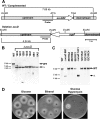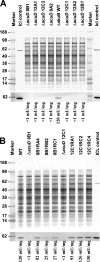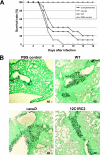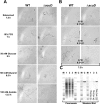Aspergillus fumigatus does not require fatty acid metabolism via isocitrate lyase for development of invasive aspergillosis
- PMID: 17178786
- PMCID: PMC1828595
- DOI: 10.1128/IAI.01416-06
Aspergillus fumigatus does not require fatty acid metabolism via isocitrate lyase for development of invasive aspergillosis
Abstract
Aspergillus fumigatus is the most prevalent airborne filamentous fungus causing invasive aspergillosis in immunocompromised individuals. Only a limited number of determinants directly associated with virulence are known, and the metabolic requirements of the fungus to grow inside a host have not yet been investigated. Previous studies on pathogenic microorganisms, i.e., the bacterium Mycobacterium tuberculosis and the yeast Candida albicans, have revealed an essential role for isocitrate lyase in pathogenicity. In this study, we generated an isocitrate lyase deletion strain to test whether this strain shows attenuation in virulence. Results have revealed that isocitrate lyase from A. fumigatus is not required for the development of invasive aspergillosis. In a murine model of invasive aspergillosis, the wild-type strain, an isocitrate lyase deletion strain, and a complemented mutant strain were similarly effective in killing mice. Moreover, thin sections demonstrated invasive growth of all strains. Additionally, thin sections of lung tissue from patients with invasive aspergillosis stained with anti-isocitrate lyase antibodies remained negative. From these results, we cannot exclude the use of lipids or fatty acids as a carbon source for A. fumigatus during invasive growth. Nevertheless, test results do imply that the glyoxylate cycle from A. fumigatus is not required for the anaplerotic synthesis of oxaloacetate under infectious conditions. Therefore, an antifungal drug inhibiting fungal isocitrate lyases, postulated to act against Candida infections, is assumed to be ineffective against A. fumigatus.
Figures




Similar articles
-
Ability to grow on lipids accounts for the fully virulent phenotype in neutropenic mice of Aspergillus fumigatus null mutants in the key glyoxylate cycle enzymes.Fungal Genet Biol. 2008 Jan;45(1):45-60. doi: 10.1016/j.fgb.2007.05.002. Epub 2007 Jun 2. Fungal Genet Biol. 2008. PMID: 17616408
-
Deletion of the Aspergillus fumigatus lysine biosynthesis gene lysF encoding homoaconitase leads to attenuated virulence in a low-dose mouse infection model of invasive aspergillosis.Arch Microbiol. 2004 May;181(5):378-83. doi: 10.1007/s00203-004-0667-3. Epub 2004 Mar 30. Arch Microbiol. 2004. PMID: 15052376
-
Deletion of the gliP gene of Aspergillus fumigatus results in loss of gliotoxin production but has no effect on virulence of the fungus in a low-dose mouse infection model.Mol Microbiol. 2006 Oct;62(1):292-302. doi: 10.1111/j.1365-2958.2006.05373.x. Epub 2006 Aug 31. Mol Microbiol. 2006. PMID: 16956378
-
[Tools, progress and questions in the molecular study of Aspergillus fumigatus and invasive aspergillosis].Pathol Biol (Paris). 1994 Sep;42(7):632-9. Pathol Biol (Paris). 1994. PMID: 7877854 Review. French.
-
Aspergillus fumigatus: contours of an opportunistic human pathogen.Cell Microbiol. 2010 Nov;12(11):1535-43. doi: 10.1111/j.1462-5822.2010.01517.x. Epub 2010 Sep 16. Cell Microbiol. 2010. PMID: 20716206 Review.
Cited by
-
Pathogenesis of Aspergillus fumigatus in Invasive Aspergillosis.Clin Microbiol Rev. 2009 Jul;22(3):447-65. doi: 10.1128/CMR.00055-08. Clin Microbiol Rev. 2009. PMID: 19597008 Free PMC article. Review.
-
Aspergillus fumigatus metabolism: clues to mechanisms of in vivo fungal growth and virulence.Med Mycol. 2009;47 Suppl 1(Suppl 1):S72-9. doi: 10.1080/13693780802455313. Epub 2009 Feb 27. Med Mycol. 2009. PMID: 19253141 Free PMC article. Review.
-
Cryptococcus neoformans requires a functional glycolytic pathway for disease but not persistence in the host.mBio. 2011 Jun 7;2(3):e00103-11. doi: 10.1128/mBio.00103-11. Print 2011. mBio. 2011. PMID: 21652778 Free PMC article.
-
Bioluminescent Aspergillus fumigatus, a new tool for drug efficiency testing and in vivo monitoring of invasive aspergillosis.Appl Environ Microbiol. 2008 Nov;74(22):7023-35. doi: 10.1128/AEM.01288-08. Epub 2008 Sep 26. Appl Environ Microbiol. 2008. PMID: 18820063 Free PMC article.
-
Metabolism of Gluconeogenic Substrates by an Intracellular Fungal Pathogen Circumvents Nutritional Limitations within Macrophages.mBio. 2020 Apr 7;11(2):e02712-19. doi: 10.1128/mBio.02712-19. mBio. 2020. PMID: 32265333 Free PMC article.
References
-
- Bishai, W. 2000. Lipid lunch for persistent pathogen. Nature 406:683-685. - PubMed
-
- Brakhage, A. A. 2005. Systemic fungal infections caused by Aspergillus species: epidemiology, infection process and virulence determinants. Curr. Drug Targets 6:875-886. - PubMed
-
- Brock, M., and W. Buckel. 2004. On the mechanism of action of the antifungal agent propionate. Eur. J. Biochem. 271:3227-3241. - PubMed
-
- da Silva Ferreira, M. E., M. R. V. Z. Kress, M. Savoldi, M. H. S. Goldman, A. Härtl, T. Heinekamp, A. A. Brakhage, and G. H. Goldman. 2006. The akuBKU80 mutant deficient for nonhomologous end joining is a powerful tool for analyzing pathogenicity in Aspergillus fumigatus. Eukaryot. Cell 5:207-211. - PMC - PubMed
Publication types
MeSH terms
Substances
LinkOut - more resources
Full Text Sources
Other Literature Sources
Medical
Molecular Biology Databases

